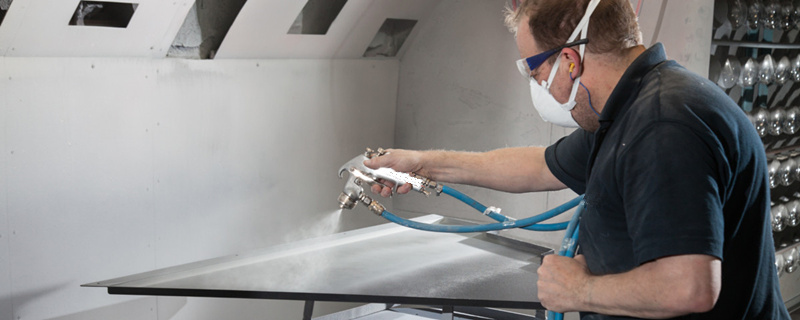Notes For Spraying Enamel Slurry or Powder
Spraying Enameling is an enameling method in which enamel slurry or enamel powder is sprayed onto the body with compressed air. The first invented spray enamel is to spray the enamel slurry onto the green body with the aid of compressed air in a spray gun, which is called wet spray enamel. In the middle of the 20th century, it was invented that the dry powder of enamel sprayed by the spray gun was adsorbed on the body to be sprayed by electrostatic attraction, which was called dry spray enamel. There are three types of wet spraying: manual spraying, automatic mechanical spraying, and electrostatic spraying. The dry method has only one type of electrostatic spraying.

Manual spray enamelling is suitable for almost all products, especially those with fine decorative patterns and complicated shapes. The disadvantage is that the production capacity is low, the labor intensity of the workers is greater, and the product quality largely depends on the proficiency of the workers.
In wet spray enamel, the caliber of the spray gun can be adjusted according to the type of enamel products and the properties of the enamel slurry. The enamel slurry can be supplied by a enamel slurry cup attached to the spray gun or an external pressure tank. When the amount of enamel slurry is small and the varieties are frequently changed, it is advisable to use the glaze cup attached to the spray gun. For example, for daily use enamel products to spray multi-color decorative patterns; when the amount of enamel slurry is large and the variety is single, use the external pressure tank as Appropriate, such as single-color grill shell, cast iron cooking utensils and spray coating of large flat building components. Since the enamel slurry is easy to precipitate, the enamel slurry in the pressure tank needs to be continuously stirred to maintain the uniformity of the enamel slurry and prevent the precipitation of the enamel slurry from affecting the spraying.
The compressed air needs to go through a multi-stage oil-water separation device before use, and even connect a condenser behind the air compressor to enhance the effect of removing oil and water. The appropriate air source pressure is 0.4~0.6MPa. In order to keep the air pressure in the spray gun stable, it is best to configure a small air tank with a certain capacity at the front end of the spraying station, and an air pressure regulator to facilitate the adjustment of the spray gun to the best working condition.
In order to achieve the best atomization effect of the enamel slurry used in wet spraying, its thickness should be finer than that of the dipping enamel. However, attention should be paid to the quality after drying and firing. The enamel slurry should not be cracked or burnt due to the fineness of the enamel slurry. Reduce defects. The enamel slurry used for spraying can ensure that the coating meets the requirements. A higher density will be beneficial, because a higher density can reduce the spraying time. For a single surface sprayed workpiece, the gun nozzle will pass very little above it. The required thickness can be achieved in a few times.
During production, the residual powder in the spray cabinet is increasing, and the forced flow of air causes the rapid volatilization of moisture to form dry enamel glaze dust. Therefore, the residual powder must be cleaned in time to maintain a good dust removal effect in the spray cabinet and reduce boiling. The city contaminates the workpieces that are still spraying enamel.
Large factories should eliminate human factors as much as possible and implement automated operations. The workpiece can be sprayed horizontally by reciprocating multiple spray guns, or it can be hung on the track and sprayed with vertical reciprocating spray guns.
Pot products are placed flat on the transmission line and sprayed with multiple fixed spray guns. Each spray gun is fixed after adjusting the spray angle as required, so that the coating on each surface of the same workpiece can meet the specified standards. When the workpiece passes through the spraying range of the spray gun, in addition to advancing along the direction of the transmission line, the workpiece is also rotating to ensure uniform spraying of the entire product.
The material supply system of mechanical spray enamel usually includes pressure tank, pipeline, liquid level control, filter screen, etc. The feeding system transports the enamel slurry to the spray gun via the pipeline. The traditional material supply adopts pressure tank, which not only serves as a material supply barrel, but also provides high-pressure transmission power. Later, it was developed into an atmospheric supply tank and a diaphragm pump to transport the enamel slurry, making it more convenient to continue the supply of enamel slurry or to change the varieties of enamel slurry and to clean up after shifts.